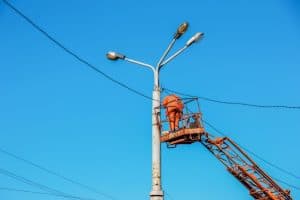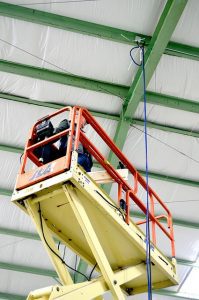Aerial Lift Hazards and What to Watch Out For 2025

If your business employs construction workers who operate aerial lifts or are consistently around them, it is essential for them to complete an OSHA-approved aerial lift certification course and learn about the manlift hazards that cause injuries and deaths every year. Enroll your workers in aerial lift safety training, and they’ll be properly prepared to recognize and avoid common hazards associated with aerial lifts.
Common Aerial Lift Hazards
Lifts can also be very dangerous, and accidents involving aerial lifts are not uncommon. According to OSHA estimates, 300 to 400 employees are hurt each year while using an aerial lift or scissor lift. Additionally, employees who are operating MEWPs, AWPs, scissor lifts, and similar equipment die from scissor accidents on average 20 to 25 times a year. There are several common hazards associated with aerial lifts, and it is important to be aware of them in order to stay safe.
One of the most common dangers is falling from the lift. This can happen if the lift tips over or if the operator is not properly secured. Another hazard is being struck by the lift itself, which can happen if the operator loses control of the equipment or if it collides with another object. It is also possible to be electrocuted if the lift comes into contact with overhead power lines. Finally, there is always a risk of being caught between two objects when working with an aerial lift. This could occur if the platform collapses or if two objects come together while the operator is between them.
Regardless of a worker’s job title, it helps to be aware of the following hazards that can affect operators of boom lifts and other types of aerial lifts. Some of the most common types of safety hazards in construction include:
Aerial Lift Hazard #1: Electrocutions
A study of the top aerial lift hazards between 1992-1999 found that nearly 50 percent of all fatalities stemmed from electrocutions. In the years since, electrocution remains a serious safety hazard. In 2017, two of the top 10 OSHA violations involved hazards related to electricity: improper lockout/tagout procedures and electrical wiring methods.
Since approximately 20% of the most common OSHA violations are in this area, you should be aware of all aerial lift hazards that could result in electrocutions. Many aerial lift operators are involved in overhead line work, and the risk of being electrocuted by live power lines and cables is a great one for these workers.
In order to protect yourself and prevent getting seriously injured or killed on the job, follow these tips provided by OSHA:
- Always wear fall protection equipment and never belt off to a pole or structure other than the lift’s attachment points.
- Do not position the lift between overhead power lines if possible.
- Treat all overhead power lines and communication cables as live, and remain at least ten feet away from them at all times.
- Be sure to have workers de-energize power lines that are in the work zone before beginning tasks, and wear protective gear like insulated hard hats, gloves, boots, and clothing.
Keep in mind that boom lifts are insulated to prevent electrical shock as well. Regardless, aerial lift operators must do what’s necessary to minimize their risk of electrocution and other manlift hazards.
Aerial Lift Hazard #2: Falls from Heights


The sheer size of aerial lifts often goes unnoticed until employees begin working. When they are improperly trained, falls can occur. To prevent falls from aerial lifts, workers need to assess their surroundings and make sure there are no objects, other vehicles, or workers nearby that may strike or come in contact with the lift. OSHA requires that all aerial lift workers wear adequate fall protection equipment that includes full-body harnesses and lanyards attached to the lift or basket. Additionally, workers need to do the following:
- Ensure all access gates or openings are closed when inside the lift basket or platform
- Stand firmly on the floor of the bucket or platform
- Never climb on or lean on the guardrails
- Never use ladders or planks in the working position while in the aerial lift bucket or platform
- Never tie off to structures or poles while in the bucket
- Always adhere to your company’s personal protective equipment (PPE) policies. This includes the proper use of safety harnesses, fall protection equipment, and other devices designed to protect you from falls from heights.
Some aerial lifts and boom lifts pose serious hazards, simply because they’re so high. If you’re unsure about your specific role and have questions about aerial lift hazards, always keep an open line of communication with your boss, site supervisor, or safety coordinator.
Aerial Lift Hazard #3: Tip-Overs/Collapses
Tip-overs are one of the most deadly types of manlift hazards. They are frequently caused by improper traveling and handling of the lift. Sometimes they are caused by inadequate pre-start vehicle and mechanical inspections. Tip-overs can result from:
- An exceeded load capacity
- Carrying too large of objects
- Driving the lift with the platform raised
- Exceeding the vertical and horizontal height limits
- Operating the lift in severe weather conditions
Collapses may occur due to mechanical failures and can be prevented by workers completing thorough pre-operation inspections of the vehicle. An inspection can go a long way to ensure that controls are working as intended. If you’re hoping to prevent tip-overs and collapses, make sure not to exceed load capacity limits. Avoid traveling to a job site with your lift raised, and new drive near holes or drop-offs. It’s also important not to raise the platform while you’re on unstable, uneven surfaces. Sloped ground and windy weather can present serious safety hazards in construction.
A widely cited study once illustrated the importance of measures to avoid tip-overs. In this case, a Montana aerial lift worker was killed when his equipment fell over on its side. Despite the potential for numerous violations, OSHA only imposed one on the company, which was a failure to report the accident within eight hours. The bottom line: aerial lift safety is a responsibility everyone shares. Employers, employees, and all personnel involved with workplace safety play a role. Aerial lift hazards – including tip-overs – are waiting to happen. It’s up to alert, properly trained employees to take the steps necessary to avoid injuries and fatalities in the first place.
Aerial Lift Hazard #4: Objects Falling from Lifts
Workers on the ground are at risk of aerial lift hazards, too. They’re sometimes injured and even killed by objects falling from the aerial lift bucket or platform above. This often occurs when lifts are used to carry objects that are larger than the platform itself. If possible, aerial lift operators should avoid positioning the lift underneath overhead objects, and workers on the ground should be aware of their surroundings and avoid working underneath or in close proximity to the lift when it is raised.
Aerial Lift Hazard #5: Ejections from Lift Platform
Ejections are one of the most dangerous types of manlift hazards. They typically happen when a lift comes into contact with another object like a sign or moving vehicle next to a highway, or from inadequate stability assurance. Before operating an aerial lift, workers need to ensure:
- Outriggers are set on pads or on a level surface on solid ground
- Brakes are set when outriggers are used
- Wheel chocks are used on sloped surfaces when it is safe to do so
- Work zone warnings are set up
An ejection from an aerial lift can occur at any time. However, aerial lift operators who plan accordingly can prevent ejections.
Aerial Lift Hazard #6: Entanglement
Ropes can be tangled up when raising or lowering an aerial lift platform. If entanglement occurs, an operator can get caught up in these ropes. This can put the operator at risk of serious injury or fatality. By staying mindful of all ropes, wires, and cords being used, workers can avoid this all-too-common safety hazard in construction.
Aerial Lift Hazard #7: Contact with Objects
Warehouse aerial lift operators can inadvertently come into contact with a ceiling if they are not careful. Meanwhile, aerial lift operators who work near power lines can engage with them, which can result in electrocution. There are also instances when an aerial lift operator does not steer or drive the machine properly. And in these instances, they may strike a building or car. Worst of all, an aerial lift operator may strike a bystander or coworker. Aerial lift hazards like these can be deadly, so it’s important to stay alert to your position while working.
How to Guard Against Common Aerial Lift Hazards
There are many things that aerial lift operators can do to protect against manlift hazards. These include:
- Conduct a pre-operation inspection. Evaluate an aerial lift before putting it into use. This requires an operator to verify that all of the lift controls are functioning correctly. An inspection should be performed before using a lift, every time. If any issues are identified, they must be addressed immediately.
- Operate a lift with precision and care. When controlling and moving an aerial lift, operators must be aware of their surroundings and ensure they have clear visibility of everything on all sides of them, especially when working near a highway.
- Wear PPE. In all cases, aerial lift operators must always wear adequate fall protection equipment to prevent them from falling from the lift. This involves wearing a full-body harness with a lanyard that is attached to the bucket or platform.
- Assess the worksite. Keep an eye out for unstable surfaces. Because placing an aerial lift on any of these surfaces can increase the risk of a tip-over. Also, if there is heavy wind or other inclement weather conditions, ensure that workers do not use an aerial lift until the conditions improve.
These are only a handful of ways to guard against aerial lift hazards. Perhaps the best strategy is to educate yourself and your colleagues. It’s not just a good idea – it’s the law.
The Impact of Proper Manlift Training
Simply put, an aerial lift operator with little or no training is an accident waiting to happen. The best way to prevent costly aerial lift hazards is to hire or train qualified AWP workers. All U.S. employers are required by OSHA to train their employees. This presents many problems, from budget to scheduling and more. Thankfully, CertifyMeOnline.net has a great selection of aerial lift and scissor lift courses to help get you OSHA compliant in no time!
Proper training is vitally important for safe, efficient AWP operation. The more you know, the better you’re prepared to handle those tough on-the-job situations. And with fines and penalties reaching upwards of $20,000, there is a smart financial incentive for your company to ensure thorough training as well.
With CertifyMeOnline.net, all of your training needs are accounted for. Our OSHA-aware modules and superior instruction cover all the bases. Along with AWP training, we also offer courses for boom lifts, fall protection, scissor lifts, and much more.
Protect Your Workers Against Manlift Hazards
Many of the most common aerial lift hazards are directly related to one of the most widely-cited OSHA violations: fall protection training requirements. By providing your workers with OSHA-approved training, you can protect them against falls and other on-the-job dangers.
CertifyMeOnline.net provides users with a solid base of knowledge in all aspects related to safe, efficient aerial lift operations. If you’d like to learn more about aerial lift hazard safety training, please call our OSHA training experts today at (602) 277-0615 or reach out online. We look forward to helping you and your company become OSHA-compliant.
